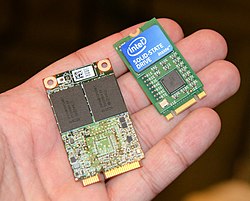
Back M.2 Bulgarian M.2 Catalan M.2 Czech M.2 Danish M.2 German M.2 Spanish M.2 Estonian ام.۲ Persian M.2 Finnish M.2 French
 An M.2 2280 solid-state drive (SSD), 22 mm wide and 80 mm long | |
| Connects to | Motherboard via one of:
|
|---|---|
| Common manufacturers | Intel Phison Realtek Samsung Silicon Motion SK Hynix |
| Design firm | PCI-SIG |
| Introduced | November 1, 2013 |
| Dimensions |
|

M.2, pronounced m dot two[1] and formerly known as the Next Generation Form Factor (NGFF), is a specification for internally mounted computer expansion cards and associated connectors. M.2 replaces the Mini SATA (mSATA) standard and the Mini PCIe (mPCIe) standard (which is how it got the short name of M dot 2 from being Mini SATA 2). Employing a more flexible physical specification, M.2 allows different module widths and lengths, which, paired with the availability of more advanced interfacing features, makes M.2 more suitable than mSATA in general for solid-state storage applications, particularly in smaller devices such as ultrabooks and tablets.[2][3][4]
Computer bus interfaces provided through the M.2 connector are PCI Express x4 (up to four lanes), Serial ATA 3.0, and USB 3.0 (a single logical port for each of the latter two). It is up to the manufacturer of the M.2 host or module to select which interfaces are to be supported, depending on the desired level of host support and the module type. Different M.2 connector keying notches denote various purposes and capabilities of both the M.2 hosts and modules, and also prevent the M.2 modules from being inserted into incompatible host connectors.[2][3][5]
The M.2 specification supports NVM Express (NVMe) as the logical device interface for M.2 PCI Express SSDs, in addition to supporting legacy Advanced Host Controller Interface (AHCI) at the logical interface level. While the support for AHCI ensures software-level backward compatibility with legacy SATA devices and legacy operating systems, NVM Express is designed to fully utilize the capability of high-speed PCI Express storage devices to perform many I/O operations in parallel.[2]: 14 [6]
- ^ Gillis, Alexander S. (July 2021). "Definition: M.2 SSD". TechTarget. Retrieved 24 February 2022.
- ^ a b c Handy, Jim; Tanguy, Jon; May, Jaren; Akerson, David; Kim, Eden; Coughlin, Tom (20 September 2014). "SNIA Webcast: All About M.2 SSDs" (PDF). SNIA. Retrieved 15 July 2015.
- ^ a b "SATA M.2 Card". SATA-IO. Retrieved 14 September 2013.
- ^ Kyrnin, Mark. "What Is M.2? New Interface and Form Factor For Compact SSD Drives in Laptops and Desktops". compreviews.about.com. Archived from the original on 15 July 2015. Retrieved 15 July 2015.
- ^ "M.2 Connector (NGFF) Introduction" (PDF). ATTEND. Archived from the original (PDF) on 3 February 2014. Retrieved 17 January 2014.
- ^ Landsman, Dave (9 August 2013). "AHCI and NVMe as Interfaces for SATA Express Devices – Overview" (PDF). SATA-IO. Retrieved 15 July 2015.